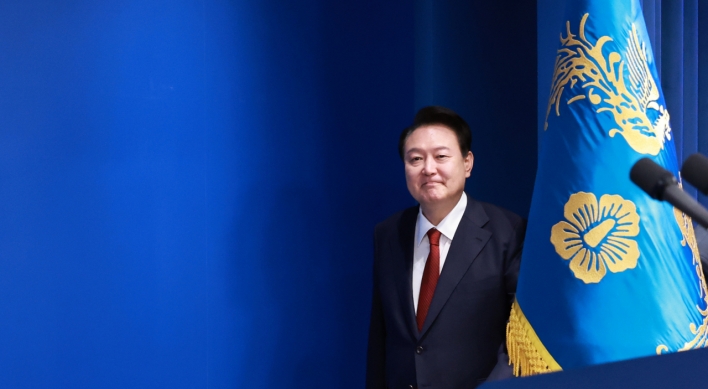Hong blurs dream and reality in ‘Nobody’s Daughter Haewon’
Typical Hong Sang-soo movie explores themes of loneliness and intimacy
By Claire LeePublished : Feb. 20, 2013 - 20:15
Memories and dreams undoubtedly have been famed director Hong Sang-soo’s favorite subjects in his work.
His latest film “Nobody’s Daughter Haewon,” unveiled to the press Tuesday, turned out to be no exception in regards to its subject matter.
In many ways, the movie, which deals with a young woman’s troubled relationship with her married teacher, is a typical Hong Sang-soo film; it again includes the pathetic male artist who gives ridiculous post break-up rhetoric; boasts Hong’s signature repetition and variation technique; and again deals with the secret affairs of those who are married. While being exactly that, the film pays a special attention to the universal themes of human loneliness and yearning for intimacy and to be remembered.
The film’s attractive yet troubled protagonist, Hae-won (played by Jeong Eun-chae), is either mistreated or misunderstood by everyone that appears in the film ― including her divorced mother who decides to move to Canada by herself, leaving her daughter alone in the country. She calls her daughter “emotionally healthy” and “spirited” ― which is the total opposite of what Hae-won actually is. The film school student is sliding into alcoholism, failing her classes, and spending much of her time sleeping in the school library.
Her married ex Seong-jun (played by Lee Seon-gyun), who is also her teacher and a filmmaker, is certainly no help in her life. It is obvious that he is not willing to give up his current wife, much less their newborn baby, for her. He constantly reminds Hae-won that she is beautiful and his love for her is genuine, but nonetheless fails to provide the kind of human intimacy that the young woman is subconsciously but desperately looking for.
His latest film “Nobody’s Daughter Haewon,” unveiled to the press Tuesday, turned out to be no exception in regards to its subject matter.
In many ways, the movie, which deals with a young woman’s troubled relationship with her married teacher, is a typical Hong Sang-soo film; it again includes the pathetic male artist who gives ridiculous post break-up rhetoric; boasts Hong’s signature repetition and variation technique; and again deals with the secret affairs of those who are married. While being exactly that, the film pays a special attention to the universal themes of human loneliness and yearning for intimacy and to be remembered.
The film’s attractive yet troubled protagonist, Hae-won (played by Jeong Eun-chae), is either mistreated or misunderstood by everyone that appears in the film ― including her divorced mother who decides to move to Canada by herself, leaving her daughter alone in the country. She calls her daughter “emotionally healthy” and “spirited” ― which is the total opposite of what Hae-won actually is. The film school student is sliding into alcoholism, failing her classes, and spending much of her time sleeping in the school library.
Her married ex Seong-jun (played by Lee Seon-gyun), who is also her teacher and a filmmaker, is certainly no help in her life. It is obvious that he is not willing to give up his current wife, much less their newborn baby, for her. He constantly reminds Hae-won that she is beautiful and his love for her is genuine, but nonetheless fails to provide the kind of human intimacy that the young woman is subconsciously but desperately looking for.

“I am leaving behind three things to this world after my death,” Seong-jun tells Hae-won in the movie. “My child, my movies, and people’s memories of me.”
But Hae-won’s own memory and experience of Seong-jun are not allowed to be shared with anyone else. His biggest fear, in fact, is having others find out about his secret affair with Hae-won, which arguably hurts her the most.
Her classmates, many of whom are jealous of her looks and the attention she gets from Seong-jun, gossip about her seemingly complicated, troubled love life; they say Hae-won may be “interracial” and her mother must be crazy-rich. It is obvious that none of them have a real grasp of who Hae-won really is; they’d rather make up stories about Hae-won than learn about the complex truth surrounding her life.
And it is her secret affair with Seong-jun that isolates Hae-won; it constantly requires her to tell lies or keep quiet when others mistreat or misunderstand her. She endures misunderstandings as well as loneliness, both in her dreams and in her reality.
“I think many often find themselves conflicted between their desires and social norms,” said director Hong during a press conference in Seoul on Tuesday, when a reporter asked him why his films often dealt with extramarital affairs.
“And I think it’s important to resolve such conflicts in life.”
Throughout the movie, Hong repeatedly shows a scene where Hae-won is asleep in the library. The English-language book she’d been reading, before falling asleep, is late German sociologist Norbert Elias’ “The Loneliness of the Dying.” The scene can be also be interpreted as Hae-won’s death.
The repeated appearance of the scene blurs the boundary between Hae-won’s reality and her dreams; viewers can’t tell whether what they are watching what’s happening in her dream or witnessing her real-life happenings. In the end, the entire movie can be seen as Hae-won’s dream, or her fantasy, or her distorted memory, or a series of real-life moments leading up to her death. The film makes the audience skeptical of the things that are considered “real,” as much as they would be of dreams and fantasies.
There are random objects that Hong also repeatedly shows throughout the film, including the cigarettes, unnamed statues, and waving flags of the country’s cultural heritage sites. They don’t add much meaning to the film’s narrative, in fact almost seem useless, but ironically create some of the most cinematic moments in the piece.
When Seong-jun weeps at Namhansanseong Provincial Park, after breaking up with Hae-won, the camera captures his sobbing shoulder from his back. The movement of his trembling shoulder resembles that of waving flags against the sunset, which is framed in the same scene. It creates a visual sentiment that beautifully represents its theme: the secrets that cannot be shared, things that are forever left unsaid, and the kind of stories that will soon be forgotten after only being gossiped by many.
The film was screened in competition at the 63rd Berlin International Film Festival, though did not win. It opens in theaters on Feb. 28.
By Claire Lee (dyc@heraldcorp.com)









![[K-pop’s dilemma] Time, profit pressures work against originality](http://res.heraldm.com/phpwas/restmb_idxmake.php?idx=644&simg=/content/image/2024/05/08/20240508050705_0.jpg&u=20240508171126)








![[Today’s K-pop] Stray Kids to drop new album in July: report](http://res.heraldm.com/phpwas/restmb_idxmake.php?idx=642&simg=/content/image/2024/05/09/20240509050659_0.jpg&u=)